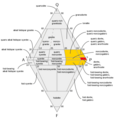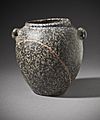Diorite facts for kids
Diorite is an igneous rock that forms deep inside the Earth. It's made mostly of minerals like plagioclase feldspar, biotite, hornblende, and pyroxene. Diorite is usually grey to dark-grey, but it can also be black or bluish-grey, sometimes with a greenish tint.
This rock is considered "intermediate" because its chemical makeup is between that of darker rocks like gabbro and lighter rocks like granite. You can tell diorite apart from gabbro because the plagioclase in diorite has more sodium and less calcium. Diorite might also have small amounts of quartz, microcline, and olivine. Other tiny minerals like zircon and magnetite are often found in it too.
Diorite has a rough, often speckled look with large grains that you can easily see. Sometimes it has bigger crystals mixed in, which is called a porphyritic texture.
A special type called orbicular diorite looks like it has circles or "eyes" in it. These circles are made of different minerals arranged in layers around a central point.
Diorite often forms near granite or gabbro rock bodies, and they can sometimes blend into each other. Diorite is created when a darker rock partly melts deep underground, usually where one of Earth's plates slides under another (a subduction zone). You often find it in areas with volcanoes or big mountain ranges, like the Andes Mountains, where it forms huge rock bodies called batholiths. The rock that forms from lava on the surface, which is similar to diorite, is called andesite.
Where Can You Find Diorite?
Diorite is not a very common rock. You can find it in places like Leicestershire and Aberdeenshire in the United Kingdom, Guernsey, Sondrio in Italy, Thuringia and Saxony in Germany, Finland, Romania, Northeastern Turkey, central Sweden, the Darrans range of New Zealand, and the Andes Mountains.
A unique orbicular type of diorite found in Corsica is even called corsite.
Images for kids
See also
 In Spanish: Diorita para niños
In Spanish: Diorita para niños

















